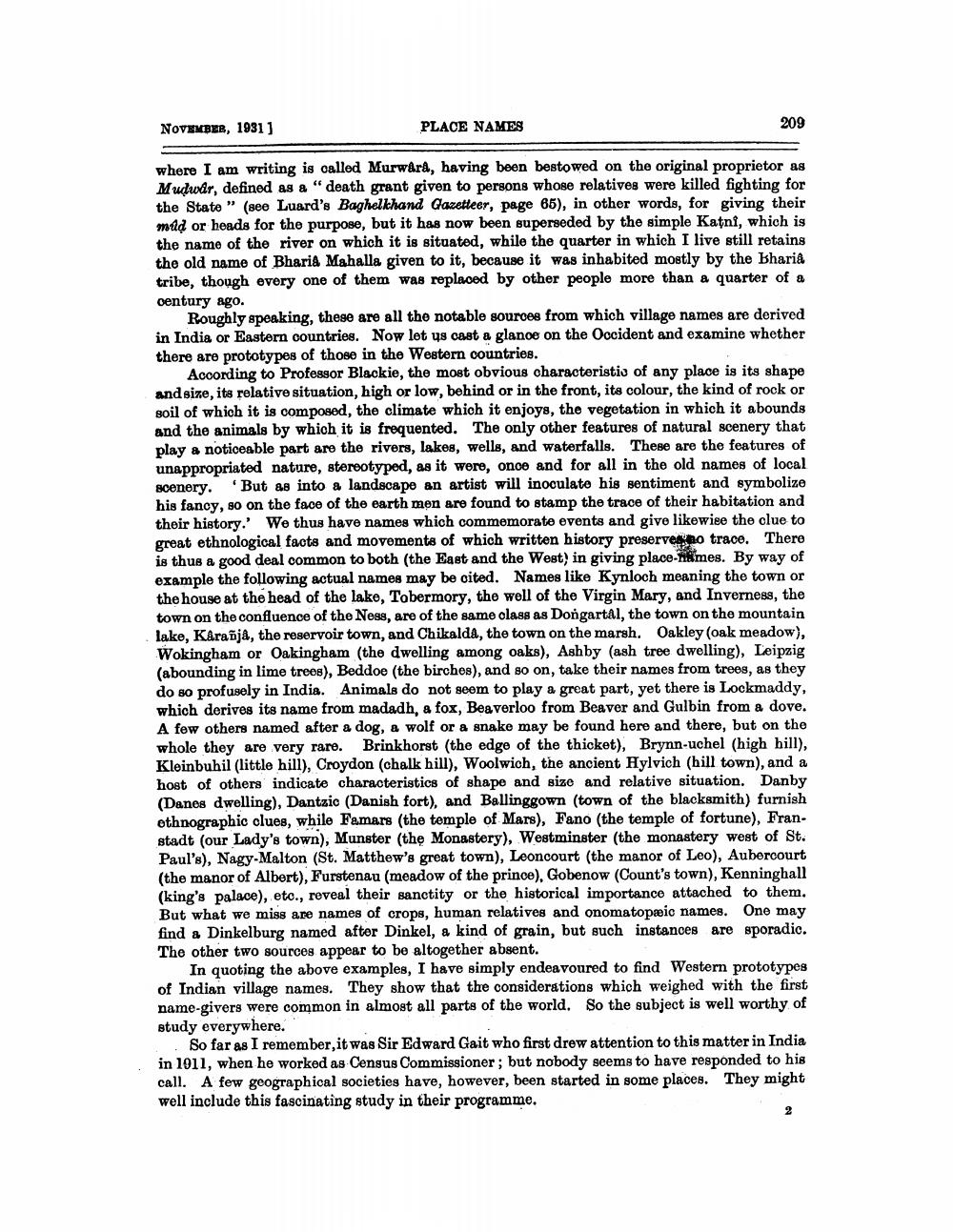________________
NOVEMBER, 1931 ]
PLACE NAMES
209
where I am writing is called Murward, having been bestowed on the original proprietor as Mudwir, defined as a " death grant given to persons whose relatives were killed fighting for the State" (see Luard's Baghelkhand Gazetteer, page 65), in other words, for giving their mid or heads for the purpose, but it has now been superseded by the simple Katni, which is the name of the river on which it is situated, while the quarter in which I live still retains the old name of Bharia Mahalla given to it, because it was inhabited mostly by the bharia tribe, though every one of them was replaced by other people more than a quarter of a oentury ago.
Roughly speaking, these are all the notable sources from which village names are derived in India or Eastern countries. Now let us cast a glanoe on the Occident and examine whether there are prototypes of those in the Western countries.
According to Professor Blackie, the most obvious characteristic of any place is its shape and size, its relative situation, high or low, behind or in the front, its colour, the kind of rook or soil of which it is composed, the climate which it enjoys, the vegetation in which it abounds and the animals by which it is frequented. The only other features of natural scenery that play a noticeable part are the rivers, lakes, wells, and waterfalls. These are the features of unappropriated nature, stereotyped, as it were, once and for all in the old names of local scenery. But as into a landscape an artist will inoculate his sentiment and symbolize his fancy, 80 on the face of the earth men are found to stamp the trace of their habitation and their history. We thus have names which commemorate events and give likewiee the clue to great ethnological facts and movements of which written history preserves no trace. There is thus a good deal common to both (the East and the West) in giving place-nikmes. By way of example the following actual names may be cited. Names like Kynloch meaning the town or the house at the head of the lake, Tobermory, the well of the Virgin Mary, and Inverness, the town on the confluence of the Ness, are of the same class as Dongartal, the town on the mountain lake, Karañjà, the reservoir town, and Chikalda, the town on the marsh. Oakley (oak meadow), Wokingham or Oakingham (the dwelling among oaks), Ashby (ash tree dwelling), Leipzig (abounding in lime trees), Beddoe (the birches), and so on, take their names from trees, as they do so profusely in India. Animals do not seem to play a great part, yet there is Lockmaddy, which derives its name from madadh, a fox, Beaverloo from Beaver and Gulbin from a dove. A few others named after a dog, a wolf or a snake may be found here and there, but on the whole they are very rare. Brinkhorst (the edge of the thicket), Brynn-uchel (high hill), Kleinbuhil (little hill), Croydon (chalk hill), Woolwich, the ancient Hylvich (bill town), and a host of others indicate characteristics of shape and size and relative situation. Danby (Danes dwelling), Dantzic (Danish fort), and Ballinggown (town of the blacksmith) furnish ethnographic clues, while Famars (the temple of Mars), Fano (the temple of fortune), Franstadt (our Lady's town), Munster (the Monastery), Westminster (the monastery west of St. Paul's), Nagy-Malton (St. Matthew's great town), Leoncourt (the manor of Leo), Aubercourt (the manor of Albert), Furstenau (meadow of the prince), Gobenow (Count's town), Kenninghall (king's palace), etc., reveal their sanctity or the historical importance attached to them. But what we miss are names of crops, human relatives and onomatopæic names. One may find a Dinkelburg named after Dinkel, a kind of grain, but such instances are sporadic. The other two sources appear to be altogether absent.
In quoting the above examples, I have simply endeavoured to find Western prototypes of Indian village names. They show that the considerations which weighed with the first name-givers were common in almost all parts of the world. So the subject is well worthy of study everywhere.
So far as I remember, it was Sir Edward Gait who first drew attention to this matter in India in 1911, when he worked as Cengus Commissioner; but nobody seems to have responded to his call. A few geographical societies have, however, been started in some places. They might well include this fascinating study in their programme.




